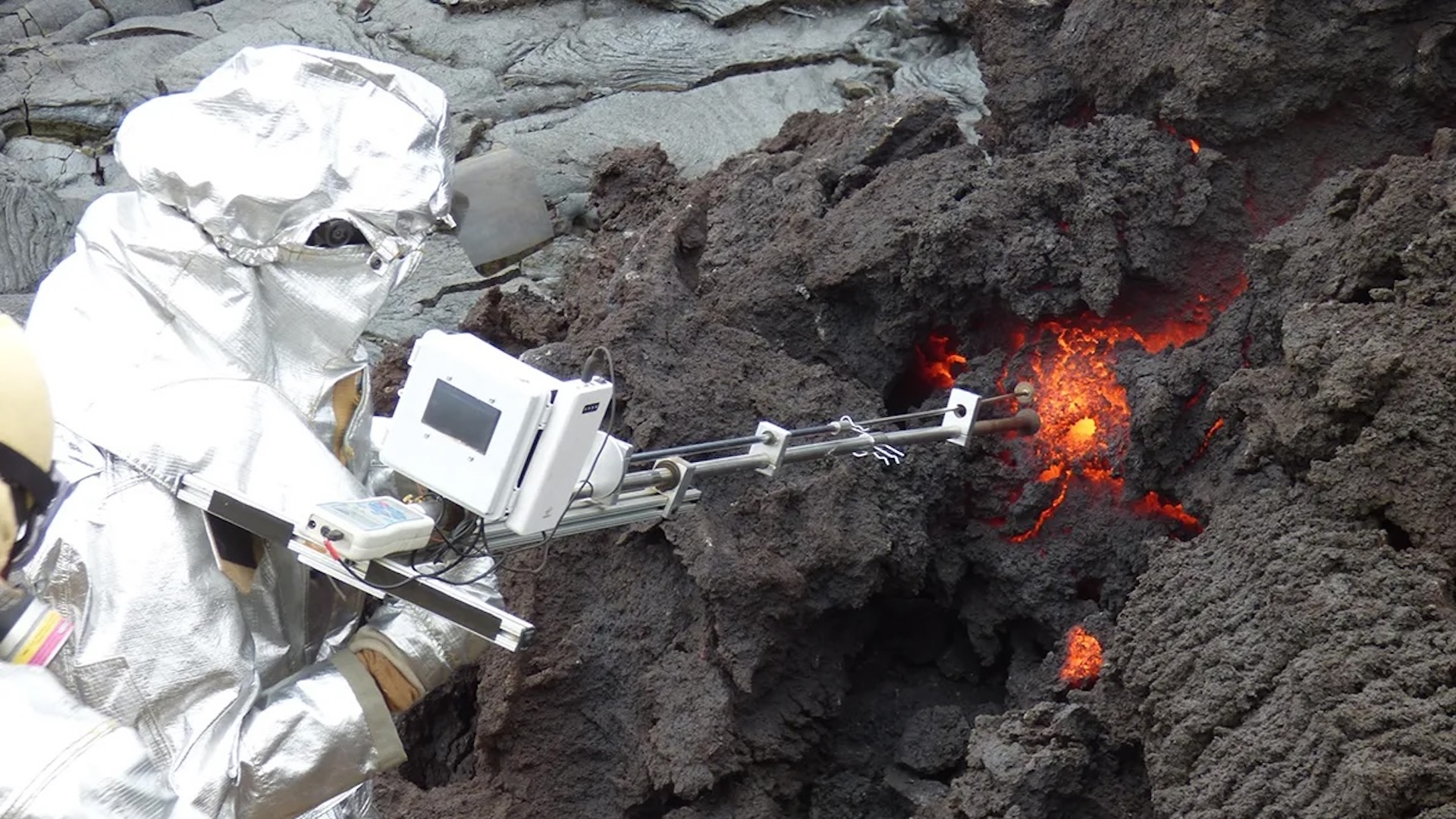Weird new device measures how 'liquid' lava is
A new device helps scientists measure lava viscosity during active flows.

Last year, scientists and students from the University at Buffalo donned protective aluminized suits and got very close to the molten material spewing from Iceland's Litli-Hrútur volcano.
"It sounds like a bulldozer of broken glass coming your way," said volcanologist Stephan Kolzenburg.
While most people would avoid getting anywhere near a volcano, the team had an important reason to be there: trying out a brand-new device, a penetrometer that measures the viscosity of lava. A new study published in Review of Scientific Instruments discusses the penetrometer and data from its first use in the field—information never before gleaned from an active lava flow.
Limitations of laboratory lava
Lava is a mixture of three phases: melt, or molten rock; bubbles, or gas contained in the melt; and crystals, or solidified and cooled materials. Knowing lava's viscosity is key to better understanding how fast it flows. Higher-viscosity lava is thick and sticky; lower-viscosity lava moves more like a liquid, or a "river of fire."
The composition and viscosity of lava vary not only between volcanoes, but also with different characteristics in a single volcano, said Alan Whittington, a volcanologist who was not involved in the new study. For example, "hot lava is generally very fluid," he explained. "As lava cools down it becomes very, very sticky indeed."
Because of this complexity — not to mention the dangers of being so close to unpredictable material over 1,832 degrees Fahrenheit (1,000 degrees Celsius) — experiments to measure lava viscosity have been limited. Previous viscosity field studies and devices revealed information about lava at only one specific place and time.
Most research on lava viscosity is done in a laboratory setting where scientists can create lava of their own. While this type of experiment does yield important information about how lava might behave in nature, it remains a very controlled endeavor.
Get the world’s most fascinating discoveries delivered straight to your inbox.
"We can remelt rocks we find and then decrease the temperature in the laboratory, and they will start to crystallize," explained Kolzenburg, one of the authors of the recent study. However, because these experiments are performed at atmospheric pressure, volatile substances like gases will create bubbles that dissolve, "and just like a can of soda pop after a few hours, will go flat. We can't contain volatiles in the laboratory," he said.

Building a better penetrometer
Because of the limitations of the laboratory — and to check data gleaned from previous artificial lava experiments — a new tool was needed to measure lava viscosity in the field. Students worked with University at Buffalo machinists to build prototypes. "The goal was to have a handheld device that could measure the viscosity of a material in a relatively large volume," said Martin Harris, a Ph.D. candidate and lead author of the recent study.
Once they were happy with a design for their penetrometer — a stainless steel device shaped a bit like a long weed whacker — they tested it in substances of varying viscosity: "Silly Putty, gels like that that we could get our hands on," said Harris.
The penetrometer needed to be long enough so that the user could stand at a close but safe distance, and portable enough to be handled by researchers of varying sizes and physical strengths. It couldn't melt once it touched the lava.
"Ultimately, the measurements themselves don't take that long. You're in for maybe 30 seconds, and you can step back and lower it and rest a little bit, then go again. It's not something that needs to be held for 10 minutes of really intense strength," said Harris.
The new lava penetrometer works by measuring the amount of force the tool needs to be pushed into a material, as well as how long it takes to go to a certain depth. These two properties, force and displacement, determine the viscosity of the surrounding material. The device itself consists of a long tube attached to a gauge that measures compressive force. On top of the tube, a second metal rod runs along a track of bearings to measure displacement.
A successful first field trial and beyond
The measurements captured in Iceland last year showed a wide range of lava viscosity, from 300 to 34,000 pascal-seconds, meaning that some lava was more fluid and some was more sticky, over a range of temperatures from 2,098 F to 2,129 F (1,148 C to 1,165 C).
"The interesting thing to me is how variable the flow might be as you actually start pushing inside it," said Whittington. "I think there's a lot to be learned. [The lava penetrometer is] an excellent complement to the remote sensing and laboratory experiment approach that we currently have. It doesn't replace either of them. But it's going to produce a lot of great new data."
Next up for Harris and the team from Buffalo is to partner with volcano observatories around the world, like one on the island of La Réunion, and train other researchers how to use the penetrometer. "That will ultimately facilitate more global studies and data sets on lava viscosity — a better understanding of what its viscosity is as it comes out of the ground. The only way that can be done is if more people are using these instruments."


